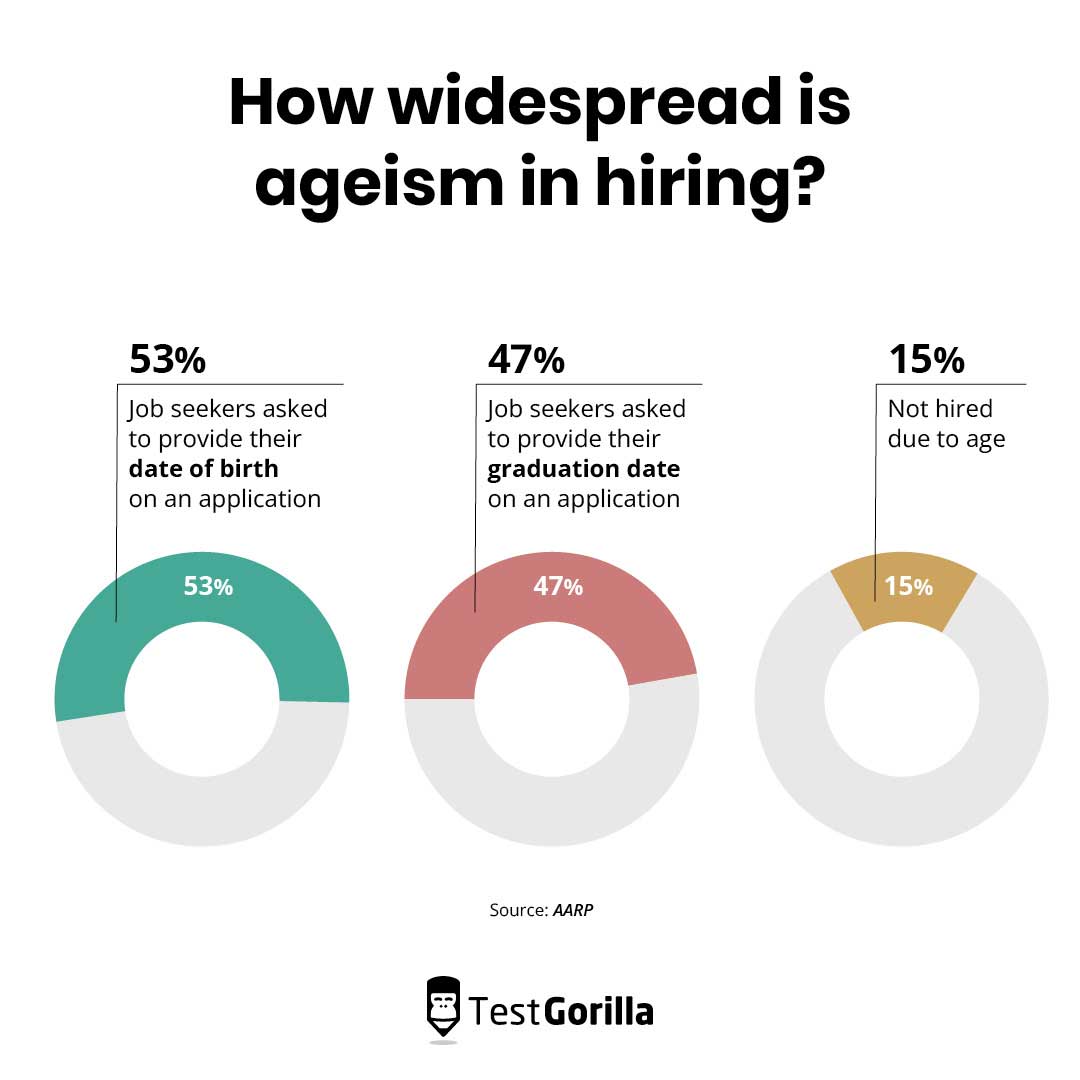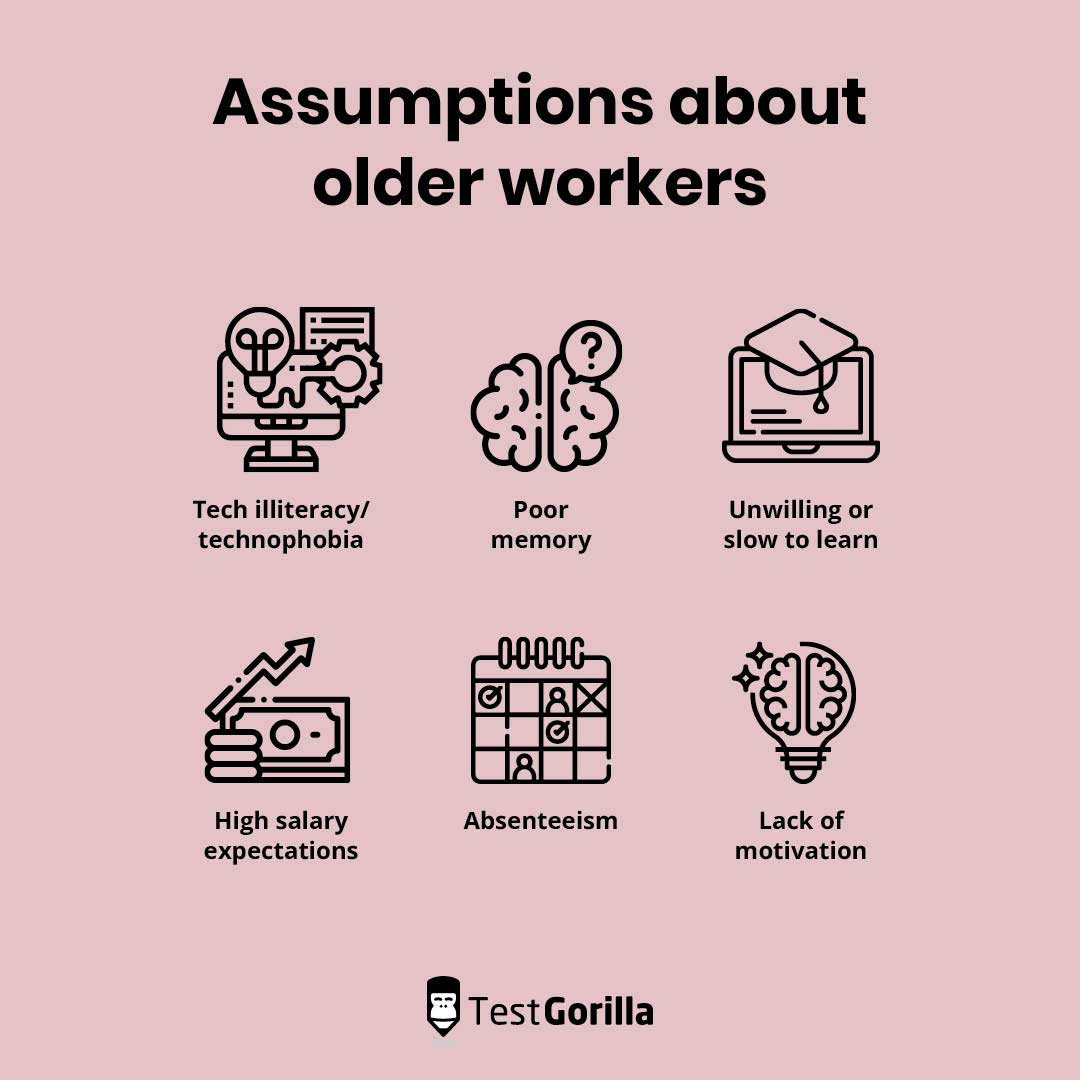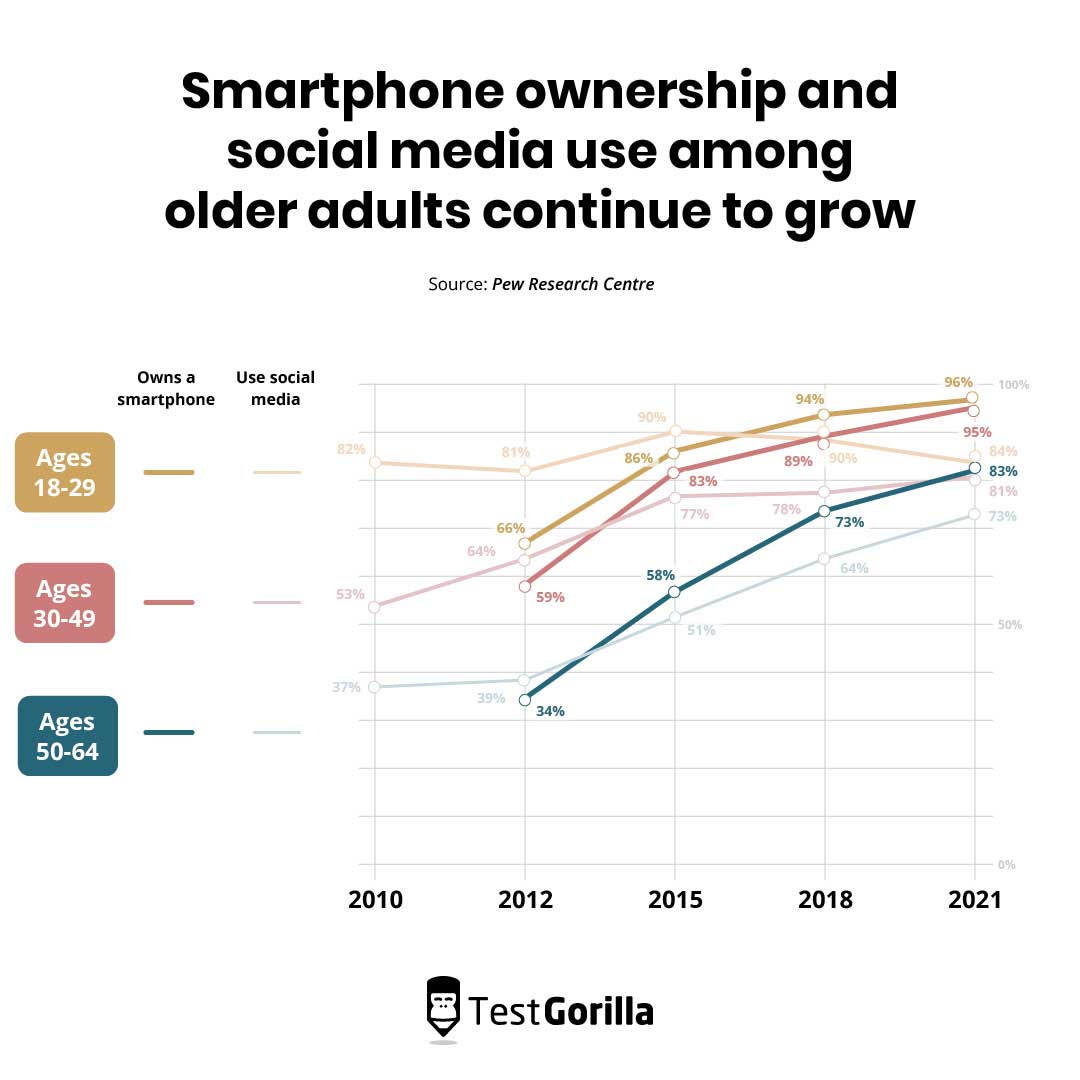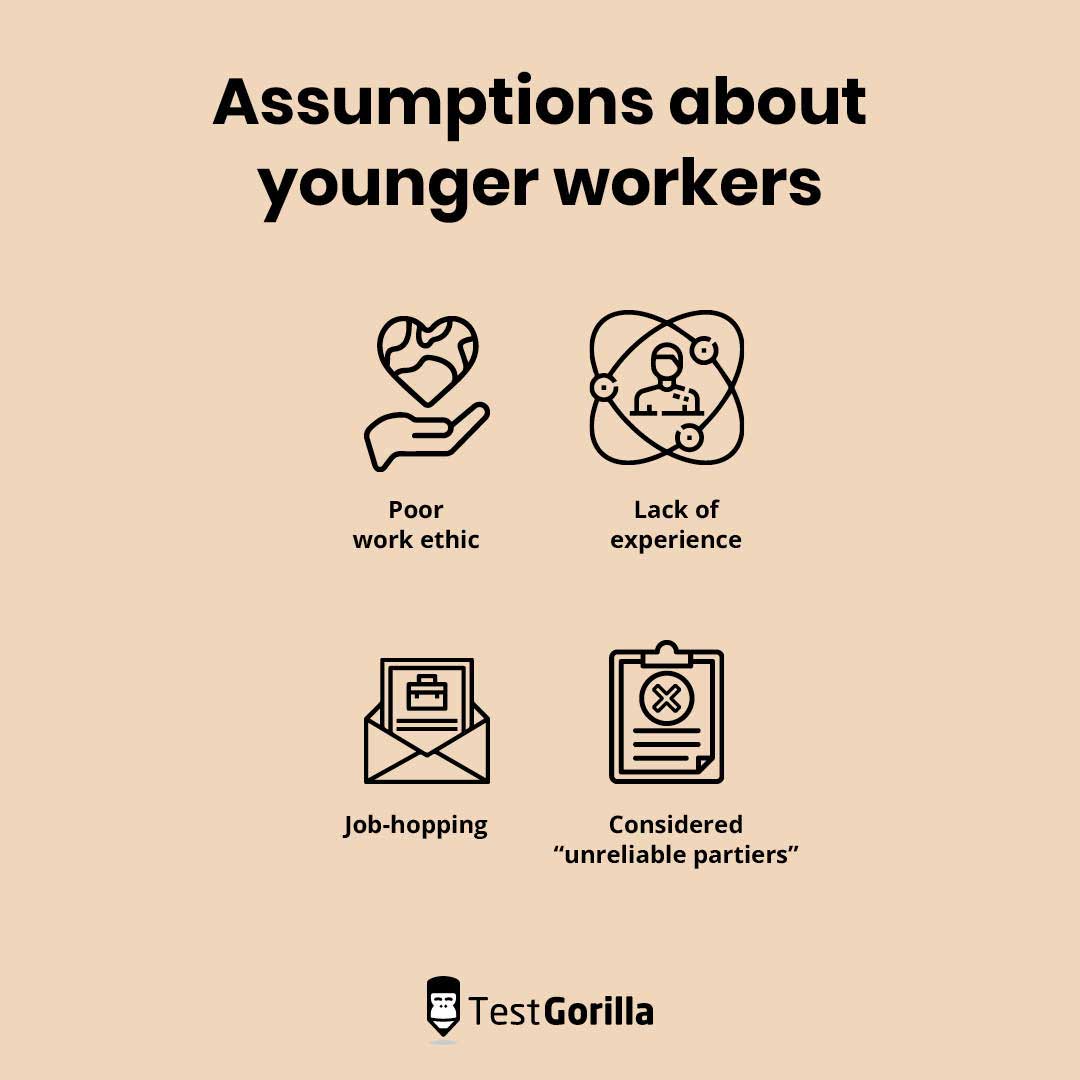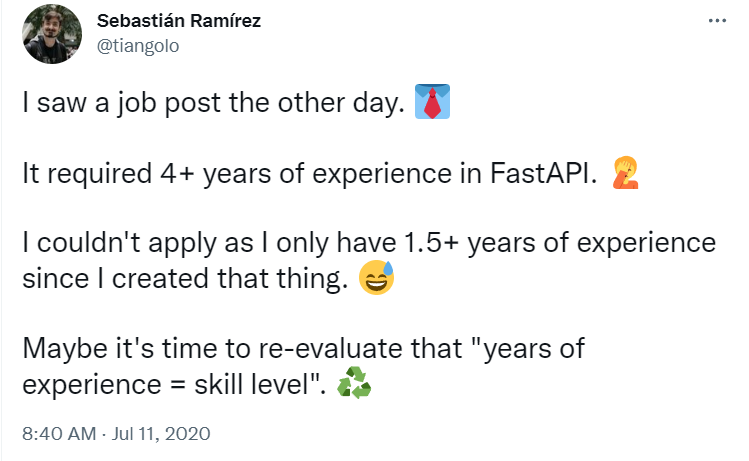Age discrimination is rampant in the hiring process and goes largely unaddressed. A 28-year-old applicant is up to three times more likely to get an interview than a 50-year-old candidate.[1]
Age discrimination, also known as ageism, is when a bias is held against a person because of their age, consciously or not.
Candidates’ capabilities and worthiness are judged based on their age every day, but employers must be conscious of this to finally bring it to an end. Every person deserves an equal shot at a job opening, and you could be missing out on stellar candidates by overlooking them based on a number.
Age doesn’t affect a candidate’s problem-solving, communication, or leadership skills. The truth is that anyone of any age can have and develop a wide array of skills.
Now is the perfect time to take steps to eliminate employment age discrimination because we live and operate in a world where much of the workforce is either aging or just getting started. These people need work, and you need a wider talent pool.
It’s a win-win.
This article covers the major assumptions made about both older and younger job seekers and the top seven best practices to help reduce age discrimination in your hiring process.
Table of contents
What is age discrimination in hiring?
Age discrimination in hiring is treating a candidate differently, usually less favorably, than you would other candidates purely because of their age.
This is most common with older candidates but can happen with young people, too.
Employment age discrimination can appear during the hiring process in many different ways, such as judging an applicant’s date of birth or graduation date.
Many people have also removed their photos from their resumes because individuals who appear older in their pictures get fewer job offers.
Another example of ageism would be a marketer being turned down for a position because she’s 49 years old, and the organization wants to push a “vibrant, youthful” image.
Let’s look at a real-life example from Andrew MacAskill, a recruiter, who mentions on his LinkedIn profile that he has gotten requests as specific as “We’re looking for a director aged 30 to 40.”
What exact skill set is only available to directors in the age group 30 to 40? That sort of request is simply judging candidates based on their age.
Ageism in recruitment can easily be combined with other biases, such as sexism and racism. For example, a candidate who is young and female may be seen as inexperienced, ignorant, and fickle.
Bias related to intersectionality happens too frequently during the hiring process, which is why TestGorilla strives for reduced unconscious bias and a focus on skills in recruitment.
How widespread is ageism in hiring?
Age discrimination in hiring is unfortunately common and affects many people.
A study by the career training organization Generation showed that 63% of unemployed people over 45 have been out of work longer than a year, versus 52% of job seekers 35 to 44 and just 36% of job seekers 18 to 34.
Another study by AARP showed evidence of age discrimination in hiring practices:
53% of job seekers have been asked to provide their date of birth on an application
47% have been asked to provide their graduation date on an application
15% have been passed over for a position because of their age – that’s nearly one in six individuals
It’s also important to remember that this study was self-reported, which could obscure the true numbers.
There could be candidates who faced ageism but didn’t believe they were discriminated against or wanted to think the best of the business.
This is especially relevant because a large amount of ageism in hiring goes undocumented as a result of recruiters unconsciously making or hiding an ageist decision because of legal restrictions.
Even more age discrimination slips under the radar because of organizations not tracking age as a diversity metric.
The best insights on HR and recruitment, delivered to your inbox.
Biweekly updates. No spam. Unsubscribe any time.
What stereotypes and assumptions cause ageism in recruitment?
Ageism isn’t a single stereotype. It encompasses many small assumptions, such as thinking that age determines memory or health.
Age discrimination in hiring happens most often to older applicants, but we’re also going to talk about assumptions made about younger workers.
Anyone being judged because of their age is experiencing ageism, although you may have heard the recent term “reverse ageism.”
Reverse ageism isn’t as broadly studied, but some research shows that older professionals tend to assume that younger workers “lack general work skills.”
The assumption that younger people are “lazy” and “entitled” and “lack motivation” can interfere with the hiring process, even if it’s an unconscious bias.
Older workers
Here is a quick look at the most common assumptions about older workers.
Assumption about older workers | Description |
Tech illiteracy/technophobia | Companies tend to assume that older workers can’t or won’t work with new tech |
Poor memory | Unfair stereotypes about older people having poor or failing memories are common |
Unwilling or slow to learn | Many people believe older workers are too stuck in their old working habits to learn new things |
High salary expectations | Businesses often assume that all older employees will want a higher salary than they can give |
Absenteeism | It’s a common misconception that older people take many days off for their health |
Lack of motivation | Some people believe that older workers don’t have drive because they’re nearing retirement |
Tech illiteracy/technophobia
Many people believe that older generations are averse to technology, and even those who aren’t can’t properly adapt to using it.
This is a tired stereotype and fails to address the rapid growth in tech use from 2015 to 2021 in people over 65.
A LiveCareer study also showed how many employees believe their tech skills are on par with those of their coworkers:
53% of millennials
54% of Gen X
64% of baby boomers
This shows how small the gap is between how advanced older and younger people believe they are with technology.
Poor memory
A commonly held belief is that older individuals have poor or failing memory. Unfortunately, this is the subject of many jokes, too.
The reasons for poor memory are much deeper and more nuanced and are linked to poor nutrition, struggling mental health, certain health conditions, stress, and trauma – not age.
Unwilling or slow to learn
Many people hold the opinion that older workers are “stuck in their ways” and unwilling or unable to learn new things.
Being rigid or unadaptable isn’t based on age. It just varies from person to person. Many older workers, even those who have been in a position for decades, are eager and willing to learn new skills and processes.
High salary expectations
Recruiters may say they can’t hire someone older because they’ll expect too much money from the position.
First, it has to be said that some older workers don’t need or want the high salary you may expect.
Additionally, many workers are driven by something other than money, such as a new experience, new skills, or a new path in life.
Absenteeism
Some people believe that older workers will have spotty attendance because they will take more sick days owing to their declining health.
However, research has shown that people in their 20s actually take twice as many sick days as those in their 50s.[2]
This shows that older people may not take the sick days they need and deserve because of their staunch work ethic.
The key takeaway is that you can’t expect any specific attendance pattern based on an employee’s age.
We believe that all workers, regardless of age, should prioritize their health and take time off when they need it.
Lack of motivation
It’s an unfortunate assumption that older workers lack motivation for their roles because they’re nearing retirement age, so they don’t need to “try” anymore.
With fewer people retiring in the modern age, older people need their jobs just as much as those at any other age. In 2020, almost 10 million Americans over 65 were working or actively looking for work.
Most older workers are also strongly dedicated to their companies. Many hold a long tenure, which saves businesses thousands in rehiring and recruiting costs and helps employers address the experience gap.
Younger workers
Age discrimination applies to young people as well. Let’s look at common assumptions about them.
Assumption about younger workers | Description |
Poor work ethic | It’s unfortunately common to say that the new generation “doesn’t want to work” |
Lack of experience | Many employers believe that young people don’t have the required work experience |
Job-hopping | There is a stereotype that young people have low retention |
Considered “unreliable partiers” | Organizations may assume that young workers spend all their time partying, making them unreliable |
Poor work ethic
“The new generation has no work ethic.”
This is probably a headline you’ve seen before, right?
Work ethic is unique to each individual and corresponds more with how connected they are to the company’s culture, values, and mission.
It also depends on what the employee is working for. One study showed that 58% of Gen Z workers are willing to work nights and weekends for better pay.
Lack of experience
The discussion surrounding job experience has been getting louder lately. Those who believe young people are inexperienced are not only ignoring the experience they possess but denying them further opportunities.
Some young people start working fresh out of school (or even while still in school) and could already have several years of experience under their belts.
Further, young job seekers could have experience and excellent transferable skills from school, extracurricular activities, camps, or clubs.
Reliance on “required years of experience” can get ridiculous since this isn’t a good measure of capability.
Job-hopping
Do younger workers jump from job to job faster than older workers?
Some younger workers do job-hop – studies show that job tenure is slightly shorter for younger people, but the numbers weren’t too different in the 1980s. So the “unreliable workers” at that time are now today’s Gen Xers and boomers.
This is generally a consequence of employers’ biases dismissing young people when it comes to upward mobility. Many individuals’ only hope for improving their careers is through job-hopping, so the best way to maintain retention among young employees is to consider them for promotions or raises on the same bases as other workers.
Unreliable or irresponsible
Some employers believe that all young workers are partiers, drinkers, and clubbers.
Two main points counter this claim:
Not all young workers are partiers
Not all partiers are unreliable
It’s important to remember that even partygoers should have the opportunity to show that they can separate their personal lives from their work lives and be professional like everyone else.
How to avoid age discrimination in hiring
Let’s look at the best practices your business can adopt to prevent age discrimination in hiring.
As an HR professional, you can directly affect the hiring process and influence your company’s culture and views on age.
Summary of the 7 strategies for reducing ageism in hiring
Strategy | Description |
Build inclusive job descriptions and roles | Start reducing ageism at the beginning of the process by writing inclusive job descriptions |
Say goodbye to the CV and switch to skills-based hiring | Reduce reliance on CVs and opt for skills-based hiring |
Hire for culture add and not culture fit | Hire for culture add to exclude fewer excellent candidates |
Never assume candidates are overqualified | Stop turning away “overqualified” candidates and treat them the same as others |
Start tracking age as one of your key diversity metrics | Learn where your organization stands in age range and hire for age diversity |
Review and follow national regulations on avoiding ageism | Ensure you’re following your area’s ageism regulations |
Help people returning to work after long absences | Implement returnship programs and build a culture that destigmatizes work gaps |
1. Build inclusive job descriptions and roles
It may be surprising, but some people won’t even bother applying for a job role if they think their age doesn’t “fit.”
Terms like “tech-savvy” and “digital native” put off older workers, and they’ll abandon the job posting without getting to the bottom of the page.
You can prevent this and build a job description that attracts all types of candidates by using inclusive terminology and eliminating ageist requirements.
Remove the following from your job descriptions:
Age bias code words – avoid including phrases like “energetic person wanted for young company” because this implies you only want to hire young people without saying it outright.
Minimum/maximum years of experience – requiring eight years of experience will automatically disqualify college graduates, but a flat “five to seven years of experience” automatically disqualifies older candidates.
Age ranges – as we mentioned above, there’s nothing specific that a director aged 30 to 40 brings to the table, so don’t make it a requirement.
For more information, check out our diversity, equity, and inclusion glossary.
Here’s another tip for more inclusive job descriptions: Make it a policy that candidates don’t have to be experts with a particular type of software.
Unless the tool is strictly necessary for the job and painstakingly difficult to master, people can quickly learn to use most software.
You can also offer software training to quickly bring new employees up to speed if needed.
2. Say goodbye to the CV and switch to skills-based hiring
There’s plenty of research to make you question the effectiveness of CVs.
They can be unreliable – 44% of workers over 45 have admitted to lying about their age on their CVs.[3]
Moreover, CVs rely heavily on “years of work experience,” a requirement we recommend removing from your hiring process altogether.
So how do you rank proficiency without a CV or resume?
Try anonymized applications and predictive, skills-based assessments. These are crucial parts of skills-based hiring.
Skills-based hiring assesses candidates based on their talent and capability, reducing the chance of unconscious bias affecting the process.
Here’s a sample skills assessment comprising tests for a growth marketer:
This assessment will zero in on the exact skill set you need with little room for bias.
If you focus on the little, irrelevant things – this person’s too old, this person’s too young – you won’t get the perfect candidate to fill the role. Evaluating their skills through pre-employment tests enables you to find the right person in less time.
TestGorilla’s own Dawn Gilfillan struggled to find a new job because of age discrimination in hiring. Many of her applications were passed over simply because of biases against older workers.
Through skills-based hiring, she found an excellent position as a writer on our blog, which enables her to display her talent and capabilities. And that’s all that should matter in your job.
Dawn is just one of our 10 skills-based hiring success stories.
3. Hire for culture add and not culture fit
Yes, there’s a difference between culture add and culture fit.
Culture fit is usually used to ensure your employees “fit” into your culture – i.e., you have the same interests and similar backgrounds, or you could have a beer together.
Unfortunately, “not fitting into our culture” is often used as an excuse not to hire older people, younger people, women, and many other groups.
Culture add is all about making a great addition to your culture. It weaves similar yet diverse people into your culture to help it grow and flourish.
This practice enables you to benefit from diverse perspectives, values, and strengths.
It isn’t always easy to manage a multi-generational labor force, but here are a few best practices to enable better co-operation that you can encourage in your culture:
Don’t overlook similarities
Focus on what each person brings to the organization
Encourage your people to fight bias and stereotypes
Always be open to learning from colleagues
Culture add gives you a diverse and inclusive workforce filled with innovation and creativity.
To read the in-depth guide, check out culture add versus culture fit.
4. Never assume candidates are overqualified
Too many employers dismiss job candidates for being “overqualified.”
Tossing aside candidates for being overqualified in terms of skill or years of experience can be an ageist issue because many are older workers.
There are many reasons an “overqualified” candidate is applying for your role and shouldn’t be turned away. They could be seeking a new life experience or need the work.
Why turn away a skilled candidate? A wealth of knowledge and life experience is a benefit and a bonus for your organization.
As long as the candidate agrees to the salary you’re offering, why shouldn’t you feel lucky to have gained such a qualified candidate?
5. Start tracking age as one of your key diversity metrics
One of the top reasons employment age discrimination is rampant in the workforce is that it isn’t monitored.
Many businesses don’t consider age part of their diversity, equity, and inclusion initiatives, so it isn’t a key metric.
Some older candidates won’t even apply for roles because of age not being considered a factor of diversity.
What’s measured is managed. Start tracking, and you’ll know for certain where you stand when it comes to your workforce’s age range.
Assessing your workforce’s current age range may surprise you, and you can start to hire more diverse age ranges after you know it.
There’s nothing wrong with intentionally hiring for workplace diversity. It brings many benefits to your organization, like increasing innovation and productivity and improving your brand image.
6. Review and follow national regulations on avoiding ageism
Yes, there are regulations surrounding age discrimination in employment.
The US and the UK (plus many other countries) have legislation against ageism in hiring, though many companies disregard it and get away with it.
Some of these rules have been in place for more than a decade, and they’re still ignored – the UK’s is the Equality Act from 2010, and the US’s is the Age Discrimination in Employment Act from 1967.
Although many businesses ignore these regulations, you can and should review and follow the national and federal laws where your organization operates.
Note: This blog post isn’t to be taken as legal advice, and you should research the regulations in your area.
7. Help people return to work after long absences
Dwelling on resume gaps is a thing of the past. The less we rely on resumes, the less we should be worrying about long work absences.
We recommend adopting an accessible returnship program. These are essentially internships aimed at folks returning to work after a long absence.
This not only offers workers a solid way to re-enter the workforce but also signals (internally and externally) that your company cares about older workers.
Destigmatizing work gaps in your business is also helpful.
They’re nothing to be ashamed of and could be due to schooling, pregnancy and parenthood, or recovery from trauma and mental health issues.
To read our in-depth guide, check out our blog on returning to work after a long absence.
Age discrimination in hiring ends here
Age discrimination in employment is unfair and biased and robs your company of thousands of potential stellar candidates.
As a hiring manager, you can take a leading role in finally eliminating age discrimination in hiring. Try adopting skills-based hiring so that you can judge candidates based on talent and not bias.
For more on this topic, read our article on the benefits of diversity in the workplace.
To evaluate your next candidate’s motivation instead of relying on stereotypes and assumptions, use our Motivation test in your next assessment.
Sources
“Older job applicants up to three times less likely to be selected for interview than younger ones, study finds”. (April, 2019). British Sociological Association. Retrieved December 2, 2022. https://www.britsoc.co.uk/media-centre/press-releases/2019/april/older-job-applicants-up-to-three-times-less-likely-to-be-selected-for-interview-than-younger-ones-study-finds/
Hall, Joe. (May 14, 2015). “Over 50s take half as many sick days as younger workers”. CITYAM. Retrieved December 2, 2022. https://www.cityam.com/over-50s-take-half-many-sick-days-younger-workers/
Garner, Mandy. (November 22, 2021). “Older workers go undercover to get hired, with 44% lying about their age on their CV”. WorkingWise. Retrieved December 2, 2022. https://www.workingwise.co.uk/older-workers-under-cover/
You've scrolled this far
Why not try TestGorilla for free, and see what happens when you put skills first.


